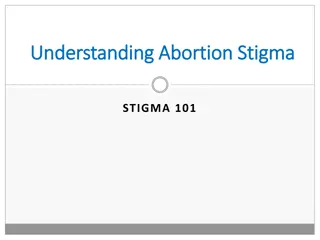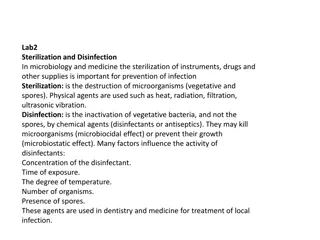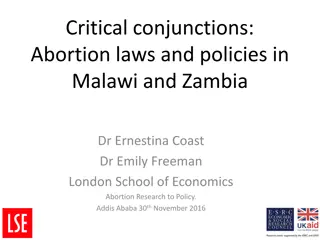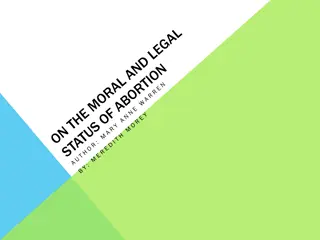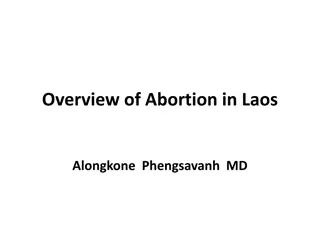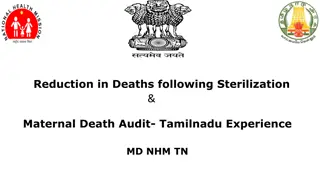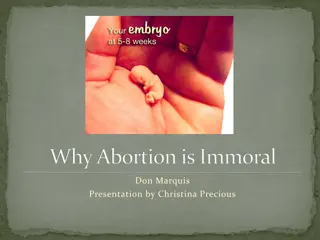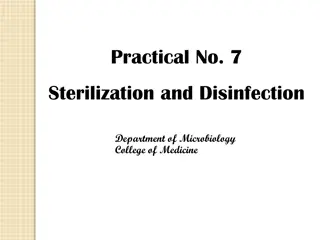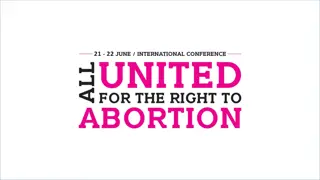Overview of Family Planning, Sterilization, and Abortion Methods
Family planning involves various methods such as sterilization and abortion for reproductive choices. Sterilization methods, including vasectomy and tubal ligation, prevent further reproduction. Abortion refers to the termination of a pregnancy through different techniques like medication-induced or surgical procedures. This comprehensive guide explains the procedures and implications of family planning methods.
Download Presentation

Please find below an Image/Link to download the presentation.
The content on the website is provided AS IS for your information and personal use only. It may not be sold, licensed, or shared on other websites without obtaining consent from the author.If you encounter any issues during the download, it is possible that the publisher has removed the file from their server.
You are allowed to download the files provided on this website for personal or commercial use, subject to the condition that they are used lawfully. All files are the property of their respective owners.
The content on the website is provided AS IS for your information and personal use only. It may not be sold, licensed, or shared on other websites without obtaining consent from the author.
E N D
Presentation Transcript
Family Planning Kamal Kumar Gupta
Sterilization Sterilization is a procedure that renders an individual incapable of further reproduction. The principal method for sterilization of males is a vasectomy (described in the Clinical Connection on page 1091). Sterilization in females most often is achieved by performing a tubal ligation , in which both uterine tubes are tied closed and then cut. This can be achieved in a few different ways. Clips or clamps can be placed on the uterine tubes, the tubes can be tied and/or cut, and sometimes they are cauterized. In any case the result is that the secondary oocyte cannot pass through the uterine tubes, and sperm cannot reach the oocyte. Tubal ligation reduces the risk of pelvic inflammatory disease in women who are exposed to sexually transmitted infections; it may also reduce the risk of ovarian cancer.
Abortion Refers to the premature expulsion of the products of conception from the uterus, usually before the pregnancy. An abortion may be spontaneous (naturally occurring; also called miscarriage) or induced (intentionally performed). twentieth week of
Abortion There are several types of induced abortions. One involves mifepristone, called miniprex in the United States and RU 486 in Europe. It is a hormone approved only for pregnancies 9 weeks or less when taken with misoprostol (a prostaglandin).
Abortion Mifepristone is an antiprogestin; it blocks the action of progesterone by binding to and blocking progesterone receptors. Progesterone endometrium for implantation and then maintains the uterine lining after implantation. If the level of progesterone falls during pregnancy or if the action of the hormone is blocked, menstruation occurs, and the embryo sloughs off along with the uterine lining. Within 12 hours after taking mifepristone, the endometrium starts to degenerate, and within 72 hours it begins to slough off. Misoprostol stimulates uterine contractions, and is given after mifepristone to aid in expulsion of the endometrium. prepares the uterine
Abortion Another type of induced abortion is called vacuum aspiration (suction) and can be performed up to the sixteenth week of pregnancy. A small, flexible tube attached to a vacuum source is inserted into the uterus through the vagina. The embryo or fetus, placenta, and lining of the uterus are then removed by suction. For pregnancies between 13 and 16 weeks, a technique called dilation and evacuation is commonly used. After the cervix is dilated, suction and forceps are used to remove the fetus, placenta, and uterine lining. From the 16th to 24th week, a latestage abortion may be employed using surgical methods similar to dilation and evacuation or through nonsurgical methods using a saline solution or medications to induce abortion. Labor may be induced by using vaginal suppositories, intravenous infusion, or injections into the amniotic fluid through the uterus.
Emergency Contraception Emergency contraception is NOT a regular method of birth control. Emergency contraception can be used after no birth control was used during sex, or if the birth control method failed, such as if a condom broke. Copper IUD Women can have the copper T IUD inserted within five days of unprotected sex. Emergency contraceptive pills Women can take emergency contraceptive pills up to 5 days after unprotected sex, but the sooner the pills are taken, the better they will work. There are three different types of emergency contraceptive pills available in the United States. Some emergency contraceptive pills are available over the counter.
Female SterilizationTubal ligation Female Sterilization Tubal ligation or tying tubes A woman can have her fallopian tubes tied (or closed) so that sperm and eggs cannot meet for fertilization. The procedure can be done in a hospital or in an outpatient surgical center. You can go home the same day of the surgery and resume your normal activities within a few days. This method is effective Typical use failure rate: 0.5%.
Female sterilization (tubal ligation) Permanent contraception to block or cut the fallopian tubes Eggs are blocked from meeting sperm >99% Voluntary and informed choice is essential
Male SterilizationVasectomy This operation is done to stop a man s sperm from going to his penis, so his ejaculate never has any sperm in it that can fertilize an egg. The procedure is typically done at an outpatient surgical center. The man can go home the same day. Recovery time is less than one week. After the operation, a man visits his doctor for tests to count his sperm and to make sure the sperm count has dropped to zero; this takes about 12 weeks. Another form of birth control should be used until the man s sperm count has dropped to zero. Typical use failure rate: 0.15%.
Male sterilization (vasectomy) Permanent to block or cut the vas deferens tubes that carry sperm from the testicles Keeps sperm out of ejaculated semen >99% after 3 months Effectiveness to prevent pregnancy 97 98% with no semen evaluation 3 months delay in taking effect while stored sperm is still present; does not affect male sexual performance; voluntary and informed choice is essential
Contraceptive use Contraceptive use has increased in many parts of the world, especially in Asia and Latin America, but continues to be low in sub-Saharan Africa. Globally, use of modern contraception has risen slightly, from 54% in 1990 to 57.4% in 2015. Regionally, the proportion of women aged 15 49 reporting use of a modern contraceptive method has risen minimally or plateaued between 2008 and 2015. In Africa it went from 23.6% to 28.5%, in Asia it has risen slightly from 60.9% to 61.8%, and in Latin America and the Caribbean it has remained stable at 66.7%. Use of contraception by men makes up a relatively small subset of the above prevalence rates. The modern contraceptive methods for men are limited to male condoms and sterilization (vasectomy).
Global unmet need for contraception 214 million women of reproductive age in developing countries who want to avoid pregnancy are not using a modern contraceptive method. Reasons for this include: limited choice of methods; limited access to contraception, particularly among young people, poorer segments of populations, or unmarried people; fear or experience of side-effects; cultural or religious opposition; poor quality of available services; users and providers bias gender- based barriers. The unmet need for contraception remains too high. This inequity is fuelled by both a growing population, and a shortage of family planning services. In Africa, 24.2% of women of reproductive age have an unmet need for modern contraception. In Asia, and Latin America and the Caribbean regions with relatively high contraceptive prevalence the levels of unmet need are 10.2 % and 10.7%, respectively (Trends in Contraception Worldwide 2015, UNDESA).




